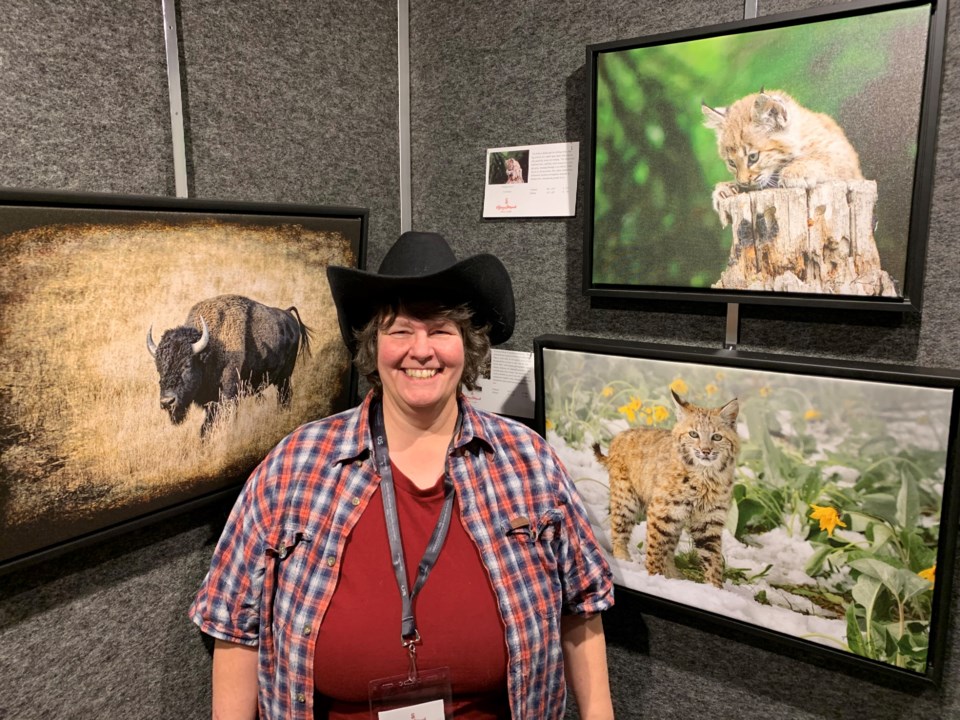A Black Diamond photographer came into focus at the 2019 Calgary Stampede, showcasing the beauty of the world around her.
The Market in the BMO Centre draws thousands of visitors each Stampede, but take a step into the Western Oasis and you will find yourself in serenity, surrounded by local, national and international artistry.
The work of Black Diamond photographer Karen Kane has been on display in the gallery since 2009.
“For me, art in general, and photography being part of that, is an exploration of the values and emotions within the artist, and then trying to create a visual which shares that with others,” she said. “In a way, it allows me to share experiences, only through images rather than conversation.”
Her interest in nature photography stems from nature being “a balance of gentleness and delicacy with strength and resiliency,” while offering a variety of shapes, colours, textures through unique places, landscapes, and wildlife.
For Kane, sharing her photography comes from a hobby rather than a profession, as she works full time as a business analyst in Calgary.
Having originally gone to university for fine arts and photography in the 80s, Kane said she switched trajectory to a science-based degree, and her photography was relegated to vacation photos for many years—until the introduction of digital photography in the early 2000s.
“It just gave so many more options and opportunities for experimenting and practising,” she said. “The joke some of the people around have is that in digital photography it costs you $2,000 for your first picture, and every one after that is free.”
She said she was interested in birds when she first got back into photography after the introduction of digital, despite a previous disinterest.
“The first image I was determined to capture was a hawk on a fence-post,” she said. “Driving around looking for hawks, there were so many other birds I ended up using Google to help identify several of them. And now I actually understand important behaviours like migration, nesting too.”
Kane said the photographic opportunities of the region are incredible; with the prairies, badlands, Rocky Mountains, or even the West-Coast rainforests being reasonably available means living in the Foothills makes her hobby quite attainable.
“It’s summer, and the canola is about to flower, it’s warm, acres of fields will be turning yellow and the skies can be their most dramatic. Then in a few months it’s winter, and everything changes,” she said. “Being able to choose between so many different environments that are each so accessible makes the Foothills area a perfect home-base for a nature photographer.”
In response to whether she researches an area or a photo beforehand, she said that the "pursuit of photography aligns with lifelong learning," and that results “are usually better if you understand the behaviour of the subject you are photographing.”
While she said she does take a lot of unplanned trips to look for subjects, the ability to do so is compounded by a body of knowledge and understanding of how to recognize opportunities built through background research.
Additionally, her planned photography trips include extensive research into the area including the subject, the best lighting, and the roads to help use the time wisely.
“I also get inspired by looking at the works of other photographers and artists,” she said of her internet research. “I can be eclectic, and if I see something new, different or innovative, I will try and figure out how or if it incorporates into my own work.”
One of the main difficulties being a wildlife photographer is the waiting involved in getting a picture that captures the character of the animal, according to Kane.
“It takes patience. Sometimes you know they’re around but you can’t see them, so you wait. Or you do see them and they’re sleeping, so you wait. Or they have their back to you—that happens a lot—so you wait,” she said. “Some people might find that frustrating, but that’s the part I seem to enjoy.
“Our world and our jobs are fast paced, (so) going out with the camera provides an opportunity to slow down and relax.”
She describes herself as “definitely not a purist” when it comes to using software to enhance her pictures, as she uses several different software packages.
In a lot of cases, she said she makes minor tweaks to enhance what caught her eye in the first place—such as a dramatic sky—while keeping it natural looking.
Other times she goes further, such as making a composite image, or even entering the realm of digital art.
“It’s like an artist who tries to produce paintings that look like photos, except I’m the photographer trying to produce photos that look like paintings,” she said.
To view her work or purchase prints, go to karenkane.smugmug.com.


